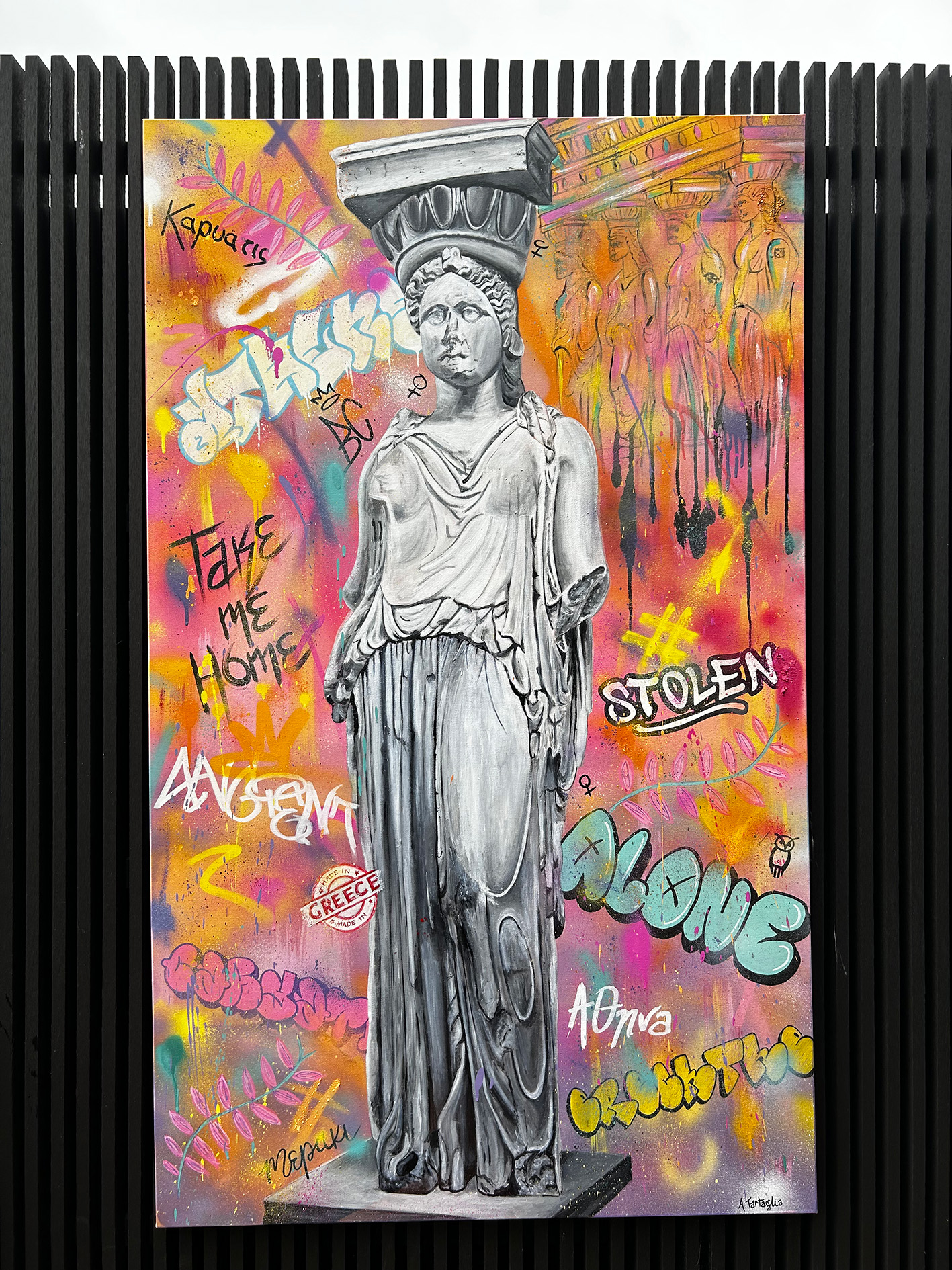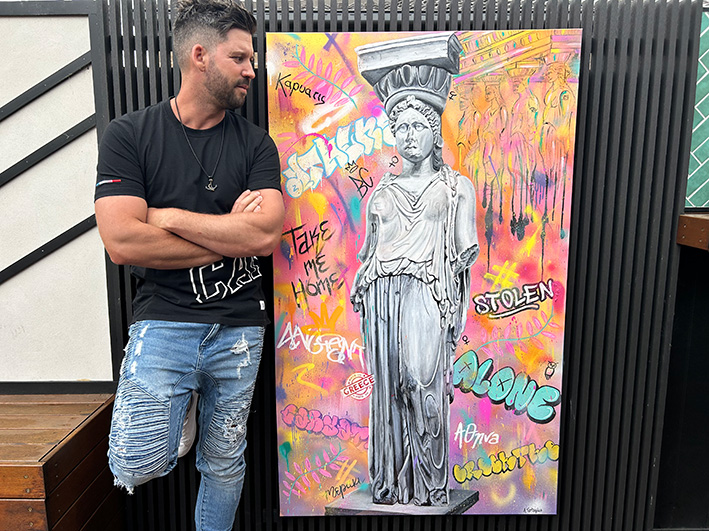Greek Australian artist Anthony Tartaglia has created a highly emotive artwork entitled ALONE in response to the global calls for the reunification of the Parthenon Sculptures, after he was approached by the Australian Parthenon Association (APA) in late 2022.
“I was overwhelmed when members of the APA saw in my work exactly what I was trying to portray, and I was overjoyed that the story I was trying to tell was seen by the right people.
“When we discussed if I would be interested in creating a piece about the fate of the cultural artworks from the Acropolis, I couldn’t wait to start,” says Tartaglia.
“The APA relay their messages through words, intellectual debate and lobbying and they’ve worked alongside key international figures. But they had heard of my passion for classical Greek art and when I learnt more about theirs, they fuelled a fire within me to join the cause.”
ALONE is a poignant and striking rendition of the widely recognised ‘missing Caryatid’ – who sits alone in the British Museum and tells her story from across the globe in an emotive exchange with the artist as she implores for her return.

Renowned Australian author, public figure and APA Chairman, David Hill, says the association is thrilled with Anthony’s piece and delighted with his interpretation, adding what better way could there be to ‘bring home’ the message of the looted Caryatid and the Parthenon Sculptures, than through art itself.
“The Greeks have been calling for the return of the Sculptures for the past 200 years.These are the most important surviving ancient artworks of the world and represent an extraordinary age of achievement for mankind.
“To see a new generation of Greek-Australian artists recognise this and to have talent such as Anthony join the fight for restitution is fantastic.” says Hill.
The 1.5m high x 900mm wide painting features the ‘stolen’ Caryatid with her sisters faded in the background, weeping for her to return and be by their side. ‘Take me home’ is one of the first things that can be read and an old-school postage stamp branded with the words ‘Made in Greece’ draws further attention to the issue. There is also an owl, the symbol of the goddess Athena, who herself is the symbol of Athens, and an olive branch which was added as the artwork neared completion – an unusual process for Anthony who typically experiments with elements and features before he commences painting.
“I chose the Caryatid because she’s the most recognised symbol of the stolen Greek artefacts and especially because she’s one that is completely separated from any collection, whether it be that in the British Museum, or that back home in Athens.
“Each of the Caryatids is also different to the next and in fact she’s also my favourite of all the sisters,” says Tartaglia.
“As I painted her, I could feel her own desire to be reunited with her sisters and their longing for her to return. It’s as if she and I were in conversation and she was begging, ‘take me back to my homeland’.
“I could feel that her sisters were missing her, and that bringing her home doesn’t need to be a cause for any further tension or debate. It’s why the olive branch was painted on as I was finishing, because it’s not only a symbol of Greece, but it’s a symbol of peace, and that’s what the sisters and all of us want.”
Anthony’s inclusion of the five Caryatids that have remained in Athens aligns with the current Greek Government’s Ministry of Culture key call to action, which stresses the importance of reunification.
“There is no doubt that you are awe struck when you first see the Caryatid and the Parthenon Sculptures wherever that may be.
“In my case, I’d been to the British Museum a few years before I’d visited the Acropolis Museum. While I was very excited to see the UK held collection for the first time, I remember becoming quite agitated and unsettled.
“A few years later when I saw the Acropolis Museum and its true and real homage to the Parthenon and the Erechtheion directly behind it, when I saw what these great ancient wonders looked like and what they were supposed to look like if they’d been left intact and as a whole, I thought back to the separated Caryatid and this really upset me.
“I now feel relieved and proud and hope that in some way by creating ALONE I can add to the legacy of my ancestors, and that I can be a part of the reunification story that’s bigger than all of us.”
ALONE took Anthony more than 30 hours to complete and is currently being prepared for display at various art exhibitions. The piece will eventually be placed for sale but Anthony says it will only go to an owner who can honour its purpose. The Caryatid and Parthenon Sculptures were removed from the Erechtheion and the Parthenon temples between 1801 to 1812.
“It is widely accepted there was no altruistic purpose for their removal, other than to adorn the country residence and gardens of Thomas Bruce, 7th Earl of Elgin, Britain’s then ambassador to the Ottoman occupiers of Greece,” Hill clarifies.
“While we cannot change history, we can right its wrongs, especially in an era where we’re increasingly unifying globally to rectify mistakes of the past.
“The Sculptures belong to all humanity, but they remain and are indisputably the cultural heritage that belongs to and is inextricably linked to the modern Greeks.” Hill concludes.
Along with the missing Caryatid, there are approximately 200 pieces from the Parthenon currently held in the British Museum that are being requested.
Australians wishing to support the call for reunification can reach out to the APA at australiansforparthenon.org.

